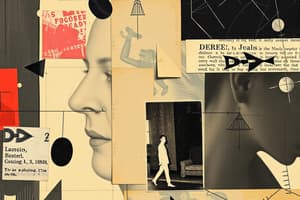Podcast
Questions and Answers
How long would it take you to realize you accidentally time traveled into the past?
How long would it take you to realize you accidentally time traveled into the past?
It depends on various factors such as the era and changes in the environment.
What is one of the most obvious general changes to notice in the past?
What is one of the most obvious general changes to notice in the past?
- Clothing styles
- Cars (correct)
- Food products
- Mobile devices
Before the invention of electricity, if you don't see wires or anything, you're in the _____.
Before the invention of electricity, if you don't see wires or anything, you're in the _____.
past
What did Johannes Gutenberg invent in the 15th century?
What did Johannes Gutenberg invent in the 15th century?
The London Underground updated its font in 2016 for a more modern look.
The London Underground updated its font in 2016 for a more modern look.
What are the two types of fonts mentioned that influence design?
What are the two types of fonts mentioned that influence design?
What might be a clue to identifying the era you are in during time travel?
What might be a clue to identifying the era you are in during time travel?
Flashcards are hidden until you start studying
Study Notes
Time Travel Discussion
- The scenario presents a thought experiment about realizing time travel based on environmental cues.
- Factors like temperature and weather remain unchanged for this exercise.
- Absence of personal items and close relationships influences the perception of time travel.
- The subjective time frame for realization varies; a personal view suggests two years might be the threshold.
Identifying Past Eras
- Key indicators for assessing the time period include technological advancements, particularly in automobiles.
- Notable observation: Cars have undergone significant design changes; differences become pronounced over approximately 20 years.
- Historical markers: Absence of modern amenities such as electricity (first harnessed in the late 19th century) signals older time periods.
Impact of Typography
- Typography, represented through fonts, serves as an important visual cue for identifying temporal context.
- The evolution of fonts illustrates advances in printing technology; Johannes Gutenberg’s printing press revolutionized book production.
- The discussion prompts consideration of alternate realities, such as if Microsoft had selected different default typefaces (Comic Sans vs. Calibri).
Modern Font Usage
- London Underground's rebranding in 2016 involves modern typography; success of this update is debated.
- Understanding the disparity between serif and sans serif fonts, and their applications gives insights into design preferences globally.
- Inquiry about the relevance of these distinctions in non-Western scripts invites broader cultural analysis.
Studying That Suits You
Use AI to generate personalized quizzes and flashcards to suit your learning preferences.



